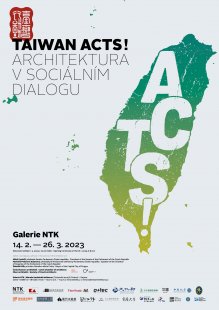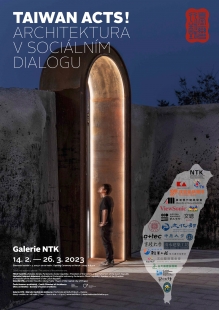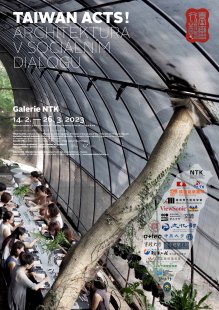
Taiwan Acts! - exhibition at NTK Gallery
Architecture as a result of social dialogue
Source
Kabinet architektury, Ostrava
Kabinet architektury, Ostrava
Publisher
Tisková zpráva
16.02.2023 18:25
Tisková zpráva
16.02.2023 18:25
Exhibitions
Czech Republic
Prague
Dejvice
Exhibition Curator: Chiu Chen-You from the Alliance for Architectural Modernity, with the support of collaborators and other institutions from Taiwan, in cooperation with the Cabinet of Architecture and the NTK Gallery of the National Technical Library in Prague.
Patrons of the exhibition:
Miloš Vystrčil, Chairman of the Senate of the Parliament of the Czech Republic
Markéta Pekarová Adamová, Chairwoman of the Chamber of Deputies of the Parliament of the Czech Republic
Zdeněk Hřib, Mayor of the Capital City of Prague
Czech Chamber of Architects
Association of Architects
The exhibition is part of the 15th edition of the international festival of architecture, design, and art Archikultura 2023.
During the week from February 27 to March 3, 2023, daily discussions will be held between leading Taiwanese and Czech architects.
This exhibition is about the emerging culture of building in Taiwan. It is the first of its kind in Europe. Since the devastating Jiji earthquake in September 1999, a number of architectural initiatives have emerged in Taiwan to focus on the social role of building, with a view to strengthening equality and sustainability of living conditions for the country's residents. Rather than dominant trends in architectural practice or sensational projects by international "star architects," the book explores socially engaged architectural projects of more humble origins. Confronting the prevalent capitalist consumerism of architecture practice that pervaded the divided society in Taiwan, these socially-driven initiatives not only include targeted measures to improve urban structures but also cultural buildings, infrastructure, and housing in many places on the island, as well as a variety of community development projects.
The first of its kind to emanate from this cultural sphere, this exhibition brings together more than 100 selected projects categorized in 5 themes according to their localities and the approaches they demonstrate. Though varying in scale and context, together they form a collection that illustrates how practitioners respond through design, architecture, and urbanism to the challenges and constraints of their respective social, economic, political, and cultural conditions. Whether conducted by professionals in a top-down approach or by non-professionals driven by grassroots movements, they testify to the practitioners’ close engagement with subjects relevant to the society they care about so passionately. Their shared ambition is to advance justice and fairness in a society of increasing division between the haves and the have-nots.
Theme 1: Making Places in Yilan
The architect Sheng-Yuan Huang began establishing his career in 1994 in Yilan, a town in the northeastern corner of Taiwan. He has worked and lived with his team at Fieldoffice Architects, and together they have played multiple roles as the initiators, mediators, designers, and users of various public projects of differing scales in the town. With financial support from the central government and the endorsement of their local communities, they have focussed their work on revitalizing the historical city center of Yilan. The main purpose of their work there is to heal the collective memory and imagination and restore the identity of the city’s residents.
Theme 2: Developing Local Communities
Ten community development projects are presented under this theme: Community Planning in Keelung, Kasing Slate Slab Houses, Kids' Bookhouse, Maple Community, Nanjichang Community, Nou-Li Association, Sin Hua Old Street, Taumi Eco-Village, Yiwu Community and Zhushan Town. Each project is the result of community members coming together to take collective action and solve common problems through design, architecture, and urbanism. The cross-disciplinary efforts bringing together civic leaders, activists, involved citizens, and professionals are aimed at improving various aspects of community conditions. Each project reflects distinct localities, identities, and cultures, and both urban and rural contexts are represented. The projects illuminate the substantive role of architecture in promoting participative democracy, sustainable development, human rights, economic opportunity, equality, and social justice, as well as social empowerment.
Theme 3: Constructing Autonomy of Architecture
This theme presents the highly individualistic creative approaches of eight architectural firms, including Atelier Or, Behet Bondzio Lin Architects, BMT Architects, Divooe Zein Architects, D.Z. Architects & Associates, ECG International Landscape consultants, EHS ArchiLab, and HARMONIOUS Architects & Planners. These projects show, on the one hand, the architects’ attempts to confront the dominant, conservative architectural practices in Taiwan, and on the other their efforts to address specific social and environmental problems. The architects find solutions by insisting on upholding social ideals, which manifests in their radical approaches to design and construction.
Theme 4: Building for World Citizens
In the past twenty years, a few architects from Taiwan have devoted their life and work to the field of humanitarian architecture generally, and post-disaster housing reconstruction in particular. They have gained invaluable skills and experiences which they have been able to implement in other parts of the world. One of the most notable of them is the architect Ying-Chun Hsieh, who, together with his affiliates at Atelier-3, has completed more than 4,000 houses in post-disaster zones across Southeast Asia over the past twenty years. Also an important figure in this scene is Guo-Chou Chen, who has built several schools and houses in rural areas of Cambodia, together with his students from the Department of Architecture at Shih Chien University. Responding to the Syrian refugee crisis in Turkey, Chen-Yu Chiu and his team at Studio Cho are another example, having designed, constructed, and managed the Taiwan-Reyhanli Centre for World Citizens in the far-away town of Reyhanli on the border of Turkey and war-torn Syria.
Theme 5: Regenerating Hsinchu City
Hsinchu is a windy coastal city with the youngest population in Taiwan. With half a million inhabitants in an area of nearly 100 km², it is a small city by Taiwanese standards. Like most such small cities, Hsinchu had suffered from low-quality public projects, poor maintenance of public spaces, and a lack of pedestrian-friendly environments. Since 2014, the then newly elected Mayor Chih-Chien Lin and his team have commissioned a series of public projects to transform and regenerate the deteriorated cityscape.
Portraying varying approaches across different disciplines, the above five themes illustrate the importance of dialogue between architecture and its society to achieve positive project outcomes when working toward a common humanistic concern. As such concerns are shared by communities around the world, the approaches demonstrated here can be learned from in various parts of the globe. This exhibition is therefore the starting point for a necessary, mutually enriching dialogue between the rapidly developing young population of Taiwan and the rest of the world.
Patrons of the exhibition:
Miloš Vystrčil, Chairman of the Senate of the Parliament of the Czech Republic
Markéta Pekarová Adamová, Chairwoman of the Chamber of Deputies of the Parliament of the Czech Republic
Zdeněk Hřib, Mayor of the Capital City of Prague
Czech Chamber of Architects
Association of Architects
The exhibition is part of the 15th edition of the international festival of architecture, design, and art Archikultura 2023.
During the week from February 27 to March 3, 2023, daily discussions will be held between leading Taiwanese and Czech architects.
This exhibition is about the emerging culture of building in Taiwan. It is the first of its kind in Europe. Since the devastating Jiji earthquake in September 1999, a number of architectural initiatives have emerged in Taiwan to focus on the social role of building, with a view to strengthening equality and sustainability of living conditions for the country's residents. Rather than dominant trends in architectural practice or sensational projects by international "star architects," the book explores socially engaged architectural projects of more humble origins. Confronting the prevalent capitalist consumerism of architecture practice that pervaded the divided society in Taiwan, these socially-driven initiatives not only include targeted measures to improve urban structures but also cultural buildings, infrastructure, and housing in many places on the island, as well as a variety of community development projects.
The first of its kind to emanate from this cultural sphere, this exhibition brings together more than 100 selected projects categorized in 5 themes according to their localities and the approaches they demonstrate. Though varying in scale and context, together they form a collection that illustrates how practitioners respond through design, architecture, and urbanism to the challenges and constraints of their respective social, economic, political, and cultural conditions. Whether conducted by professionals in a top-down approach or by non-professionals driven by grassroots movements, they testify to the practitioners’ close engagement with subjects relevant to the society they care about so passionately. Their shared ambition is to advance justice and fairness in a society of increasing division between the haves and the have-nots.
Theme 1: Making Places in Yilan
The architect Sheng-Yuan Huang began establishing his career in 1994 in Yilan, a town in the northeastern corner of Taiwan. He has worked and lived with his team at Fieldoffice Architects, and together they have played multiple roles as the initiators, mediators, designers, and users of various public projects of differing scales in the town. With financial support from the central government and the endorsement of their local communities, they have focussed their work on revitalizing the historical city center of Yilan. The main purpose of their work there is to heal the collective memory and imagination and restore the identity of the city’s residents.
Theme 2: Developing Local Communities
Ten community development projects are presented under this theme: Community Planning in Keelung, Kasing Slate Slab Houses, Kids' Bookhouse, Maple Community, Nanjichang Community, Nou-Li Association, Sin Hua Old Street, Taumi Eco-Village, Yiwu Community and Zhushan Town. Each project is the result of community members coming together to take collective action and solve common problems through design, architecture, and urbanism. The cross-disciplinary efforts bringing together civic leaders, activists, involved citizens, and professionals are aimed at improving various aspects of community conditions. Each project reflects distinct localities, identities, and cultures, and both urban and rural contexts are represented. The projects illuminate the substantive role of architecture in promoting participative democracy, sustainable development, human rights, economic opportunity, equality, and social justice, as well as social empowerment.
Theme 3: Constructing Autonomy of Architecture
This theme presents the highly individualistic creative approaches of eight architectural firms, including Atelier Or, Behet Bondzio Lin Architects, BMT Architects, Divooe Zein Architects, D.Z. Architects & Associates, ECG International Landscape consultants, EHS ArchiLab, and HARMONIOUS Architects & Planners. These projects show, on the one hand, the architects’ attempts to confront the dominant, conservative architectural practices in Taiwan, and on the other their efforts to address specific social and environmental problems. The architects find solutions by insisting on upholding social ideals, which manifests in their radical approaches to design and construction.
Theme 4: Building for World Citizens
In the past twenty years, a few architects from Taiwan have devoted their life and work to the field of humanitarian architecture generally, and post-disaster housing reconstruction in particular. They have gained invaluable skills and experiences which they have been able to implement in other parts of the world. One of the most notable of them is the architect Ying-Chun Hsieh, who, together with his affiliates at Atelier-3, has completed more than 4,000 houses in post-disaster zones across Southeast Asia over the past twenty years. Also an important figure in this scene is Guo-Chou Chen, who has built several schools and houses in rural areas of Cambodia, together with his students from the Department of Architecture at Shih Chien University. Responding to the Syrian refugee crisis in Turkey, Chen-Yu Chiu and his team at Studio Cho are another example, having designed, constructed, and managed the Taiwan-Reyhanli Centre for World Citizens in the far-away town of Reyhanli on the border of Turkey and war-torn Syria.
Theme 5: Regenerating Hsinchu City
Hsinchu is a windy coastal city with the youngest population in Taiwan. With half a million inhabitants in an area of nearly 100 km², it is a small city by Taiwanese standards. Like most such small cities, Hsinchu had suffered from low-quality public projects, poor maintenance of public spaces, and a lack of pedestrian-friendly environments. Since 2014, the then newly elected Mayor Chih-Chien Lin and his team have commissioned a series of public projects to transform and regenerate the deteriorated cityscape.
Portraying varying approaches across different disciplines, the above five themes illustrate the importance of dialogue between architecture and its society to achieve positive project outcomes when working toward a common humanistic concern. As such concerns are shared by communities around the world, the approaches demonstrated here can be learned from in various parts of the globe. This exhibition is therefore the starting point for a necessary, mutually enriching dialogue between the rapidly developing young population of Taiwan and the rest of the world.
The English translation is powered by AI tool. Switch to Czech to view the original text source.






0 comments
add comment











